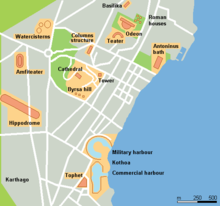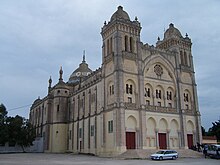| Carthage | |
 | |
| Information | |
| Country | Tunisia |
| Postal Code | |

Carthage - an ancient city-state in North Africa, located on the coast of the Mediterranean Sea. It was initially founded in the 9th century BC. by the Phoenicians of Tire as a city near today Tunis. A very important commercial and political center.
Characteristic
The 6th century BC Phoenician city was the base of a mighty trading empire spanning the entire southern Mediterranean coast with a population of half a million. The legendary founder of the Queen, Dido, bought "as much soil as a cow's skin can cover" from the locals, and by carefully cutting the cow's skin she gained Byrsa Hill. its most famous general was Hannibal, who crossed the Alps to fight the Romans. Hannibal was defeated against the Roman general Scipio "Africanus" in the Battle of Zama in 202 BCE, which ended the 2nd Punic War. After more than 50 years of being closely watched by Rome, they were finally attacked during the 3rd Punic War. Citizens defended the city against the Roman Republic in 146 BCE, but they still lost it, and Punic Carthage was completely destroyed by order of the Senate. The site was rebuilt by the Romans a century later, and Carthage became the capital of the Roman province of Africa. Sites with UNESCO World Heritage List.
The Byrsa hill at the rear of this area dominates both the sea bay and the lake and plain of Tunis in the hinterland to the west and is therefore the most strategic point.
Today the district is very affluent, with elite schools, wealthy residents, a relatively numerous police force, a large number of archaeological sites and museums, and the seaside residence of the president.
Drive
By plane
There is an international airport here.
By rail
Carthage is included in the Tunisian railroad system.
Take the TGM train from Tunis to one of the following stations:
- Carthage-Amilcar - only useful in the American Cemetery
- Carthage-Présidence - to the Saint Cyprien Basilica or for a walk next to the President's Palace
- Carthage-Hannibal - most places, including Antony's Baths, Roman Theater and Carthage Museum / Acropolium / Archaeological Park
- Carthage-Dermech
- Carthage-Byrsa - Oceanographic Museum, Punic Tophet and nearby hotel
- Carthage-Salammbo
By car
Local road junction.
By bus
By ship
Communication
Usually it's best to walk. However, the area is large and sightseeing is a sweaty job on a hot day.
Taxi
If you are tired you can take a taxi between some of the main tourist spots. It should be cheaper off season.
For example 10 DT (December 2010) From museum downstairs to amphitheater including 10 minutes driver wait, water tank tour, another 5 minutes driver wait and trip to Tophet.
Worth seeing


Carthage
Lots of ruins! President's Palace. Beautiful views of Tunis and the bay.
You can buy a ticket for 10 DT (November 2018) which allows you to access around 10 different historical places which are a big challenge to see in one day. Only some places have extensive English signage - many, like the museum, are gone. Some are not open and most of the signposts pointing to where they are are sketchy at best.
The most impressive monuments (with better preserved ruins) are the Baths of Antony and the Hill of Byrs near the Carthage Museum. The Amphitheater, Odeon Hill, and Water Cisterns are much smaller but still interesting.
- 1 Antony's Baths Ruins of the largest Roman baths outside Rome itself. There is also a Punic cemetery on site, some old houses, some Punic stoves, a chapel, some tombs and mosaics. The guides are available in many languages and can be cost effective as the position is large. It is illegal to photograph towards the presidential palace. This way, especially when traveling alone, you can end up in jail for up to 3 years, although the guards don't seem too concerned.
- 2 Carthage Museum Most of the remains recovered from the ruins were kept in the cavernous museum on Byrsa Hill, documenting the Punic and Roman eras. The signs at the museum are entirely in Arabic and French. On the second floor, the part closer to the stairs presents artifacts from Roman times, and the inner part artifacts from the earlier Punic period. Fascinating artifacts remain, such as alabaster jars and jewelry. The descriptions of the Roman conquest and the legend of Dixon are also vivid, but unfortunately not accessible to English speakers. The museum grounds offer spectacular views of the coast and the city, as well as the ruins of some Punic streets, the former site of a public library, numerous sculptures, a chapel or church, magnificent mosaics and coffins. A few benches under the trees with a beautiful view are a good place to rest. Unfortunately, many of the items on the site are unmarked, so a guide might come in handy (or eavesdrop on the tour group if you can). Ignore the sneaky guy trying to charge you 1 DT to use the toilet. As of November 2018, visitors only have access to the museum grounds and the museum building is closed for reconstruction.

- Acropolium St. Ludwika is one edge of the museum, but does not appear to be open - it was completed in 1890.
- 3 Water cisterns A very large series of water tanks that acted as a water redistribution point at the end of a long (90 km?) Aqueduct from the hills to the south. The remains of the end of the aqueduct are still standing. It also offers reasonable views of the city.
- 4 Amphitheater Gutted Roman amphitheater built in the 1st century CE, surrounded by forested hills. Interesting for a quick walk but not signposted in any language. Maybe therefore be more interesting with an enthusiastic guide. Worth seeing. The adjacent forest can be a nice picnic spot.
- 5 Punic Tofet, Rue Hannibal (This is the part of the island that protrudes into a circular bay - road signs can be misleading). Frustratingly unmarked but large collection of what appears to be a children's tomb. Many stones have simplified symbols carved on them. There are also some partially buried structures. Guide or background reading recommended.
- 6 Saint-Cyprien Basilica, North of Carthage Présidence station along Route La Goulette / Rue de Rue de Maroc (Go north a few hundred yards from the station, turn right with the sign just after the bridge and the gas station on your left.). This historic Christian temple was surrounded by a vast cemetery. Rediscovered in 1915, it was oriented towards a spectacular ocean view that can still be admired. The temple is believed to be dedicated to the welfare of seamen. All valuable debris has been removed, leaving the site somewhat empty. The upside is that it's a good picnic spot. There is a chocolate and cake shop nearby and there is a beverage service station in front of you. Located very far north of most Carthaginian ruins, this is a good option to start a long day of walking
- 7 the presidential palace, Route La Goulette (Between Carthage-Hannibal and Carthage-Présidence stations on a hill. Look for national flags!)). You can walk past the well-guarded President's Palace, which includes a private boat dock and a helipad on the main road. You can also see it from the Baths of Antony and the ruins above (walk under the TGM railway bridge and then turn right up the hill). Not accessible to the public, but the view can be seen from a distance.
- 8 Paléochrétien Museum Built on the site of an excavation, it lies over the former Carthaginian basilica (Dermech Basilica). Permanently closed.
- 9 Odeon Hill and Roman Villa Park
- 10 Carthage Circus The Roman circus used for chariot racing was modeled on the Circus Maximus in Rome and other circus buildings throughout the Roman Empire. Over 470 meters long and 30 meters wide, it can accommodate up to 45,000 spectators. There is not much left of it now.
Different places
- 11 Cemetery and memorial to American soldiers who died in North Africa during World War II (North of Carthage, five minutes walk from Amilcar station.). The cemetery is the resting place of 2,841 American soldiers who died in the North African War. The monument is named after 3,724 Americans whose remains have never been found or identified. The Memorial Court contains large mosaic and ceramic maps depicting operations in Africa.
- 12 Musée Océanographique Dar El Hout, rue du 2 mars Salammbô 28 (Walk east towards the water from Carthage Salammbo station) and then follow the lake), ☎ 216 71 730420. Built in 1924 under President Zine El Abidine Ben Ali on the site of Carthage's military port. Collection of stuffed birds and animals, several aquariums, skeletons of fossil fish
Nearest neighborhood
work
Science
Shopping
Other than travel knick-knacks, unless you're looking for high-end furniture or everyday items and food, your options may be limited.
Gastronomy
There are many eateries in the area, though most are off the main tourist trail.
Carthage-Byrsa and Carthage-Salammbo area
- Near Punic Tophet on Rue de Hannibal south of Carthage-Byrsa south station, east of Carthage-Salammbo is a hotel-restaurant with a relatively expensive but good choice (including wines). It's not far from the Oceanographic Museum
- North of Carthage-Byrsa, two local sandwich shops offer cheap meals and coffee.
- On the main road, Route La Goulette, between Carthage-Byrsa and Carthage-Salammbo stations, there is a restaurant that offers a wide selection of salads, meat dishes, sandwiches and pizzas.
- Le Rest'O, Byrsa, Carthage, 216 71 733 433. Mediterranean cuisine and elegant interior. Great views of the entire city and the bay
Carthage-Hannibal
- Antony's Baths Cafe. A small cafe in the Antony Baths area. Hot / cold drinks and some snacks.
Carthage-Présidence
- Sale sucre (on the corner in front of Saint Cyprien Basilica). Doesn't work out of season. A small pastry shop. Drinks can be bought in front of the gas station.
Drinks
The hotel / restaurant on Rue de Hannibal, southwest of Punic Tophet, offers a wine selection, albeit Tunisian and more expensive. Beers also seem to be available.
Events, parties
- Carthage International Festival in summer it is a treat for famous dancers, singers and artists from all over the world for a very reasonable price (10.5 DT). Plastic chairs are not worth the price (26 DT) unless you really care about supporting your back. Most people bring pillows or blankets for the seats in the amphitheater. Plan a late night with concerts that usually end after 1am.
Accommodation
- Villa Didon (next to the main Carthage ruins at the top of Byrsa Hill). This expensive hotel / spa offers food near the Carthage Museum. It has a stylish lounge and a terrace with great views. Very enjoyable for an evening beer or glass of wine, although seemingly closed out of season. From 634 TN
contact
Security
Tourist information
Where next
- Halk al-Wadi
- La Marsa
- Sidi Bou Said - This cute little town is just a few train stations from Carthage and is a great place to eat and watch the sunset
- Tunis - the laid back capital of Tunisia with a very authentic bitch

